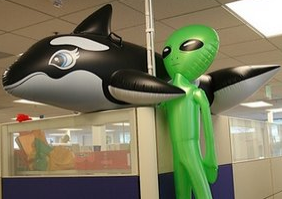Office Space: Thinking Beyond the Lonely Cubicle
by Amy Curtis | July 25, 2011

If you ask children what they want to be when they grow up, the response probably isn’t “I want to work in a small office cubicle.” Sure, not every kid can realize their fantasies of being an astronaut, pirate, or president of the United States. But I also don’t believe work has to be devoid of stimulation or adventure.
My 5’2” frame and inability to play basketball have effectively squashed my childhood dreams of being a WNBA player. But I still have high aspirations for an interesting and rewarding career. I want a job that allows me to engage with intelligent individuals, foster relationships, better the community, explore our world, think critically, develop personally, and maybe even laugh a bit while doing it. Yet can I do all this within the walled confines of an office?
Knowing that I can’t be a student forever, I decided to explore the options for “desirable” office environments around the country. The probability of me working in an office seems high, so I sought to identify workspaces that go well beyond bare white walls and dreaded fluorescent lighting.
And guess what? They do exist: interesting, stimulating, and interactive office spaces where I would certainly aspire to work.
Here are a few offices I’ve found that would make any child re-think his desire to be a rodeo clown:
- The Googleplex: The technology giant’s sprawling office complex has gained notoriety of late for being a dynamic place to work. Check out this TIME photo essay or the GoogleMaps tour, and I think you’ll see why. Located in Santa Clara, California, Google headquarters fosters an environment that caters to the young, enthusiastic, curious, and intelligent. This includes three free meals a day, massages, swimming pools, and abundant spaces to think and play.
- Pixar Headquarters: Pixar has dominated the field of animation in terms of both innovation and box-office success. The office behind the creativity? Just as innovative as you’d expect. Check out the photos here (note the small hut that doubles as an office cubicle).
I agree that not every office can be as elaborate as Google’s or Pixar’s, the champions of creativity. But what about an insurance or software company?
- Take, for instance, software developer Fog Creek. There might not be free massages on the perimeter, but the space includes a marble shower for those who choose to bike to work, a lunch place with unlimited free food, and a library filled with books and comfortable leather chairs—perfect for a light nap after lunch. See pictures of the space taken by the owner here.
- The Los Angeles advertising firm TBWA attempts to create an entire “advertising city” for its 450-person community. The complex is full of color, outdoor spaces, light, and even full-sized basketball courts. Check out this interesting video guide to the community and how the creativity of the physical space itself fosters creativity within.
The four offices I’ve described above may be elaborate and costly, but it’s not the money spent that defines an enjoyable, creative, inspiring space. Take the folks at the Happy at Work Project. Their office consists simply of large tables, big windows, lots of nature, and open spaces to breathe, think, and engage.
For a different type of work experience, consider the movement toward shared or communal workspaces—also known as “coworking”—which is especially inviting for freelancers and other folks who would otherwise work alone. For a small fee, you can rent a desk in a comfortable but professional environment and meet other "coworkers" who may be doing very different work from you. The result? A stimulating and social space to get your everyday tasks done. Check out the Coworking Directory to find a coworking space near you.
Offices shouldn’t be isolating places that segregate and restrict. They should facilitate discussion, interaction, and innovation. To create happy workers, employers need to rethink the everyday office environment: less uniformity, more community.
Amy Curtis is a student at the University of Virginia and an intern at New Dream.

